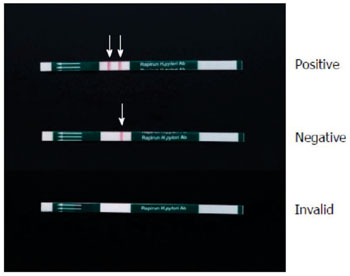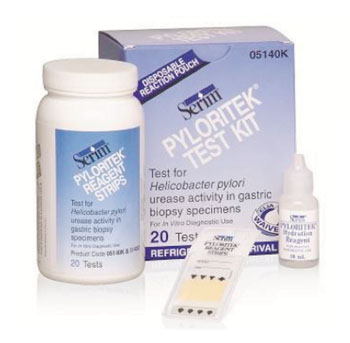Rapid Urine Test Evaluated for Helicobacter Pylori Infection
|
By LabMedica International staff writers Posted on 26 Jun 2014 |

Image: Rapirun Helicobacter pylori Antibody Stick. The urine sample is considered positive when two red bands at the test line and control line (arrows) are observed after 15 minutes and is considered negative when only the control line is observed. The absence of a control line indicates an invalid result (Photo courtesy of Duc T Quach).

Image: The PyloriTek rapid urease test to detect Helicobacter pylori (Photo courtesy of Serim Research Co.).
A rapid urine test based on enzyme-linked immunosorbent assay (ELISA) has been developed for the detection of anti-Helicobacter Pylori antibodies in urine.
Several methods to diagnose H. pylori infection have been developed, among which the urea breath test (UBT) is currently regarded as the most accurate assay, but the UBT is still expensive and not widely available in many countries.
Scientists at the Ho Chi Minh City Medicine and Pharmacy University (Vietnam) working with Japanese colleagues, enrolled 200 patients undergoing upper gastrointestinal endoscopy from October 2012 to December 2012. Three biopsies were taken from each patient: two for histologic examination and one for the rapid urease test (RUT).
The biopsy for RUT was taken from the greater curvature of the corpus, about 2 cm above the atrophic border. This biopsy location has been reported to optimize the sensitivity of the PyloriTek RUT to detect H. pylori (Serim Research Co.; Elkhart, IN, USA). Urine samples were collected and were processed within one hour of collection for the detection of antibodies against H. pylori using the Rapirun Helicobacter pylori Antibody Stick (Otsuka Pharmaceutical Co., Ltd.; Tokyo, Japan). The test measures human immunoglobulin G (IgG) antibodies against H. pylori in urine using the principle of immunochromatography.
Of the 200 patients, 111 (55.5%) were diagnosed as being H. pylori positive. The sensitivity, specificity, and accuracy of the Rapirun Stick test were 84.7%, 89.9%, and 87.0%, respectively. There were 17 (8.5%) false-negative patients and 9 (4.5%) false-positive patients. Of the 24 patients with gastro-duodenal ulcer, 22 (91.7%) had H. pylori infection. However, 7 of 22 (31.8%) patients with reflux esophagitis also had the infection.
The authors demonstrated the usefulness of the Rapirun Stick test for the diagnosis of H. pylori infection in a Vietnamese population and the sensitivity, specificity, and accuracy of the Rapirun Stick test were high. In several patients, RUT and histologic examination produced false-negative or false-positive results, leading to the possible misdiagnosis of H. pylori infection. The study was published on May 7, 2014, in the World Journal of Gastroenterology.
Related Links:
Ho Chi Minh University of Medicine
Serim Research Co.
Otsuka Pharmaceutical Co.
Several methods to diagnose H. pylori infection have been developed, among which the urea breath test (UBT) is currently regarded as the most accurate assay, but the UBT is still expensive and not widely available in many countries.
Scientists at the Ho Chi Minh City Medicine and Pharmacy University (Vietnam) working with Japanese colleagues, enrolled 200 patients undergoing upper gastrointestinal endoscopy from October 2012 to December 2012. Three biopsies were taken from each patient: two for histologic examination and one for the rapid urease test (RUT).
The biopsy for RUT was taken from the greater curvature of the corpus, about 2 cm above the atrophic border. This biopsy location has been reported to optimize the sensitivity of the PyloriTek RUT to detect H. pylori (Serim Research Co.; Elkhart, IN, USA). Urine samples were collected and were processed within one hour of collection for the detection of antibodies against H. pylori using the Rapirun Helicobacter pylori Antibody Stick (Otsuka Pharmaceutical Co., Ltd.; Tokyo, Japan). The test measures human immunoglobulin G (IgG) antibodies against H. pylori in urine using the principle of immunochromatography.
Of the 200 patients, 111 (55.5%) were diagnosed as being H. pylori positive. The sensitivity, specificity, and accuracy of the Rapirun Stick test were 84.7%, 89.9%, and 87.0%, respectively. There were 17 (8.5%) false-negative patients and 9 (4.5%) false-positive patients. Of the 24 patients with gastro-duodenal ulcer, 22 (91.7%) had H. pylori infection. However, 7 of 22 (31.8%) patients with reflux esophagitis also had the infection.
The authors demonstrated the usefulness of the Rapirun Stick test for the diagnosis of H. pylori infection in a Vietnamese population and the sensitivity, specificity, and accuracy of the Rapirun Stick test were high. In several patients, RUT and histologic examination produced false-negative or false-positive results, leading to the possible misdiagnosis of H. pylori infection. The study was published on May 7, 2014, in the World Journal of Gastroenterology.
Related Links:
Ho Chi Minh University of Medicine
Serim Research Co.
Otsuka Pharmaceutical Co.
Latest Immunology News
- Blood Test Could Identify Colon Cancer Patients to Benefit from NSAIDs
- Blood Test Could Detect Adverse Immunotherapy Effects
- Routine Blood Test Can Predict Who Benefits Most from CAR T-Cell Therapy
- New Test Distinguishes Vaccine-Induced False Positives from Active HIV Infection
- Gene Signature Test Predicts Response to Key Breast Cancer Treatment
- Chip Captures Cancer Cells from Blood to Help Select Right Breast Cancer Treatment
- Blood-Based Liquid Biopsy Model Analyzes Immunotherapy Effectiveness
- Signature Genes Predict T-Cell Expansion in Cancer Immunotherapy
- Molecular Microscope Diagnostic System Assesses Lung Transplant Rejection
- Blood Test Tracks Treatment Resistance in High-Grade Serous Ovarian Cancer
- Luminescent Probe Measures Immune Cell Activity in Real Time
- Blood-Based Immune Cell Signatures Could Guide Treatment Decisions for Critically Ill Patients
- Novel Tool Predicts Most Effective Multiple Sclerosis Medication for Patients
- Companion Diagnostic Test for CRC Patients Identifies Eligible Treatment Population
- Novel Tool Uses Deep Learning for Precision Cancer Therapy
- Companion Diagnostic Test Identifies HER2-Ultralow Breast Cancer and Biliary Tract Cancer Patients
Channels
Clinical Chemistry
view channel
POC Breath Diagnostic System to Detect Pneumonia-Causing Pathogens
Pseudomonas aeruginosa is a major cause of hospital-acquired and ventilator-associated pneumonia, particularly in lung transplant recipients and patients with structural lung disease. Its ability to form... Read more
Online Tool Detects Drug Exposure Directly from Patient Samples
Doctors often rely on patient interviews and medical records to determine what medications a person has taken, but this information is frequently incomplete. People may forget drugs they used, take over-the-counter... Read moreMolecular Diagnostics
view channel
STI Molecular Test Delivers Rapid POC Results for Treatment Guidance
An affordable, rapid molecular diagnostic for sexually transmitted infections (STIs) has the potential to be globally relevant, particularly in resource-limited settings where rapid, point-of-care results... Read more
Blood Biomarker Improves Early Brain Injury Prognosis After Cardiac Arrest
After a cardiac arrest, many patients remain unconscious for days, leaving doctors and families facing uncertainty about whether meaningful recovery is possible. Current tools to assess brain damage, including... Read more
Biomarkers Could Identify Patients at High Risk of Severe AKI After Major Surgery
Acute kidney injury is one of the most common and dangerous complications after major surgery, particularly among patients in intensive care. Even mild impairment of kidney function can lead to long-term... Read more
CLIA Test Identifies Head and Neck Cancer Recurrence from Post-Surgical Lymphatic Fluid
While the lymphatic system’s critical role in metastasis has long been recognized, routine access to patient lymph has been elusive. Now, a non-invasive process can access lymph through the collection... Read moreHematology
view channel
MRD Tests Could Predict Survival in Leukemia Patients
Acute myeloid leukemia is an aggressive blood cancer that disrupts normal blood cell production and often relapses even after intensive treatment. Clinicians currently lack early, reliable markers to predict... Read more
Platelet Activity Blood Test in Middle Age Could Identify Early Alzheimer’s Risk
Early detection of Alzheimer’s disease remains one of the biggest unmet needs in neurology, particularly because the biological changes underlying the disorder begin decades before memory symptoms appear.... Read more
Microvesicles Measurement Could Detect Vascular Injury in Sickle Cell Disease Patients
Assessing disease severity in sickle cell disease (SCD) remains challenging, especially when trying to predict hemolysis, vascular injury, and risk of complications such as vaso-occlusive crises.... Read more
ADLM’s New Coagulation Testing Guidance to Improve Care for Patients on Blood Thinners
Direct oral anticoagulants (DOACs) are one of the most common types of blood thinners. Patients take them to prevent a host of complications that could arise from blood clotting, including stroke, deep... Read moreImmunology
view channel
Blood Test Could Identify Colon Cancer Patients to Benefit from NSAIDs
Colon cancer remains a major cause of cancer-related illness, with many patients facing relapse even after surgery and chemotherapy. Up to 40% of people with stage III disease experience recurrence, highlighting... Read moreBlood Test Could Detect Adverse Immunotherapy Effects
Immune checkpoint inhibitors have transformed cancer treatment, but they can also trigger serious immune-related adverse events that damage healthy organs and may become life-threatening if not detected early.... Read morePathology
view channel
Rapid Low-Cost Tests Can Prevent Child Deaths from Contaminated Medicinal Syrups
Medicinal syrups contaminated with toxic chemicals have caused the deaths of hundreds of children worldwide, exposing a critical gap in how these products are tested before reaching patients.... Read more
Tumor Signals in Saliva and Blood Enable Non-Invasive Monitoring of Head and Neck Cancer
Head and neck cancers are among the most aggressive malignancies worldwide, with nearly 900,000 new cases diagnosed each year. Monitoring these cancers for recurrence or relapse typically relies on tissue... Read more
Common Health Issues Can Influence New Blood Tests for Alzheimer’s Disease
Blood-based tests for Alzheimer’s disease are transforming diagnosis by offering a simpler alternative to spinal taps and brain imaging. However, many people evaluated at memory clinics also live with... Read more
Blood Test Formula Identifies Chronic Liver Disease Patients with Higher Cancer Risk
Chronic liver disease affects millions worldwide and can progress silently to hepatocellular carcinoma (HCC), one of the deadliest cancers globally. While surveillance guidelines exist for patients with... Read moreTechnology
view channel
Machine Learning Models Diagnose ALS Earlier Through Blood Biomarkers
Amyotrophic lateral sclerosis (ALS) is a rapidly progressive neurodegenerative disease that is notoriously difficult to diagnose in its early stages. Early symptoms often overlap with other neurological... Read more
Artificial Intelligence Model Could Accelerate Rare Disease Diagnosis
Identifying which genetic variants actually cause disease remains one of the biggest challenges in genomic medicine. Each person carries tens of thousands of DNA changes, yet only a few meaningfully alter... Read moreIndustry
view channel
BD and Penn Institute Collaborate to Advance Immunotherapy through Flow Cytometry
BD (Becton, Dickinson and Company, Franklin Lakes, NJ, USA) has entered into a strategic collaboration with the Institute for Immunology and Immune Health (I3H, Philadelphia, PA, USA) at the University... Read more



















